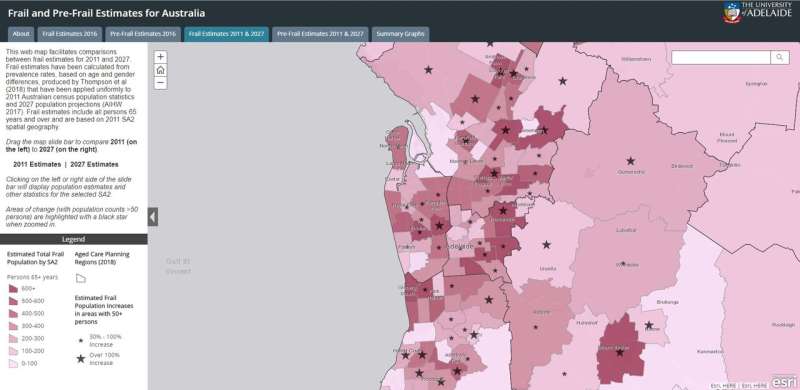First frailty map highlights service need

An online interactive map, which shows for the first time where Australia's frail and pre-frail people live today and in the future, will help plan services for healthy aging.
The frailty web map has been developed by researchers at the University of Adelaide's NHMRC Centre of Research Excellence in Frailty and Healthy aging. Dr. Danielle Taylor is the research leader of the frailty web map project.
"Frailty is an increased vulnerability to adverse health outcomes, such as loss of mobility, falls leading to hospitalization and death," she says.
"Frailty is associated with aging, but is not an inevitable consequence of aging. It is a preventable and treatable condition that reduces the quality of life of many older people.
"The first step in addressing frailty is to identify people who are frail or likely to become frail (pre-frail). While this can be done on an individual level by frailty screening, on a population level, geospatial population modeling can be used to model frailty prevalence and identify frail and pre-frail populations and how their distribution is likely to change in the future."
The interactive map shows population estimates of the number of frail and pre-frail people within all Australian suburbs for 2011, 2016 and 2027. It shows that the number of frail people in some suburbs around capital cities are projected to double. Examples of these include among others:
- Sydney—Padstow, Chatswood, Bexley, Hurstville
- Melbourne—Epping, Mulgrave, Keilor East
- Canberra—Monash, Florey, Rivett
- Brisbane—Eagleby, Raceview, Birkdale
- Adelaide—Hallett Cove, Happy Valley, Mount Barker and Golden Grove
- Perth—Armadale, Canning Vale, Bassendean, Kingsley
- Darwin—Fannie Bay, Rapid Creek, Wanguri
- Hobart—Risdon Vale, Brighton, South Hobart
In 2016 3.6 million Australians (15.7 percent of the total population) were over 65 years old. More than half of them are estimated to be frail (more than 415,000) or pre-frail (1.7 million) and the number is expected to grow rapidly. It's estimated that more than 600,000 people will be frail and 2.2 million pre-frail in 2027. The growth is expected to be fastest in regional, remote and outer metropolitan areas.
"Australia is the first country to have an interactive frailty map and that shows where frail and pre-frail people live and is in a unique position to address this growing issue," says Dr. Taylor.
"This information can be used to inform resource distribution, such as the provision of health services to areas that are likely to have a high level of need."
"The map is available for anyone to use including individuals or community groups that may wish to use the information to advocate for additional local services."
Frail people need assistance from physiotherapists, dietitians, occupational therapists, social workers, aged care assessment services and community services to help alleviate the effects of aging.
"This is a step forward in the way frailty can be identified, leading to more targeted treatment and prevention and ultimately a reduction in frailty prevalence. It also raises awareness of the projected rapid growth of frailty and the need to act to prevent and better manage frailty," says Dr. Taylor.
"Reducing frailty will improve the quality of life of many older Australians, enabling them to remain independent and living for longer in their own homes, while also reducing the higher utilization of health services, a characteristic of frailty."
















